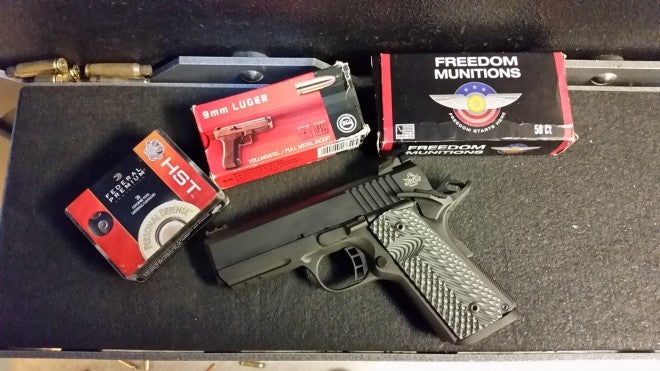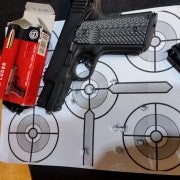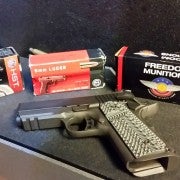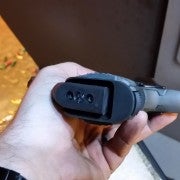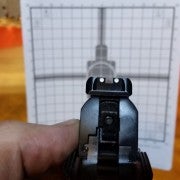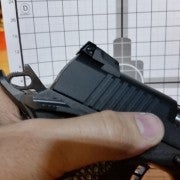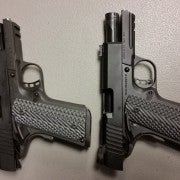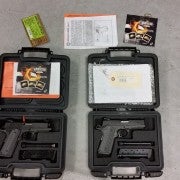Review: Rock Island Armory TAC ULTRA CS 1911s (9mm & .45 ACP)
It’s not often that we are asked to test multiple handguns at the same time. In fact, I wasn’t expecting more than one and it was a surprise when Rock Island sent out two of their latest 1911s for T&E. I am not complaining, as the two were their latest releases from their growing TAC series. The Tac series focuses on getting tactically (go figure) features into the handguns for the best price possible. Knowing there is a tradeoff between price and features, I was curious to dive straight in.
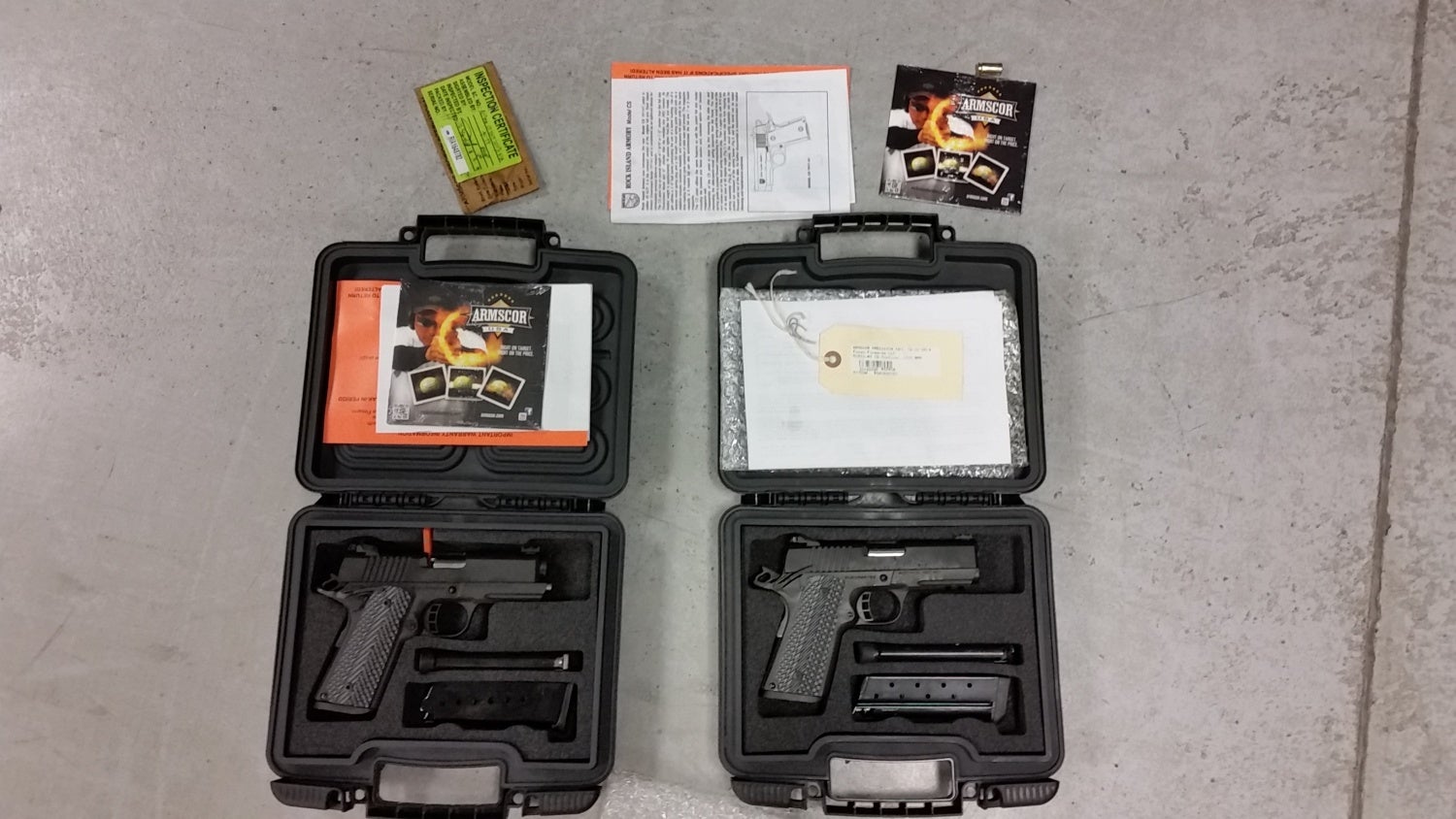
The 1911 CS’ as they arrive with accessories.
Overview
It was a great day when the Rock Island Armory MS 1911s arrived for testing at the shop. Due to my move late last year, the handguns were shipped to my day job where many a co-worker are 1911 fans. As soon as I had them unboxed and near the A&D book for entry, the ink had not dried before the two disappeared into the hands of my Sales Manager who promptly gave them a full shake-down.
We affectionately refer to him as our “Ogre” so the Officer-sized handguns looked comparatively small in his hands. Not one to baby a gun (we use him for torture testing internally on our own rifles), the handguns were immediately and incessantly, tapped, racked, and dry-fired nearly so many times I was afraid we would break a firing pin. His pronouncement upon the completion of his man-handing was “Nice… I like the grips.”
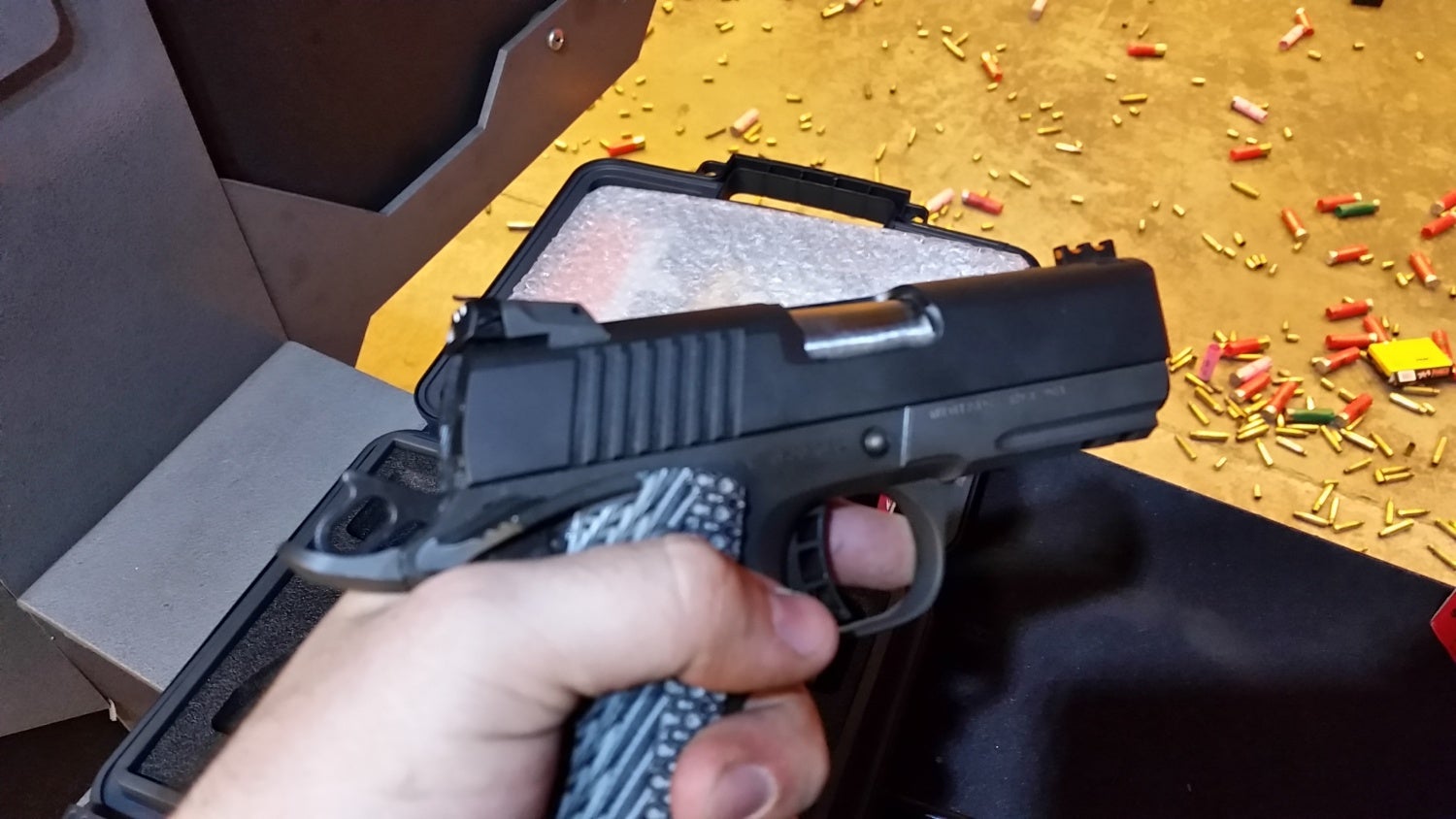
Grippy!
Now with at least one of the handguns in my possession we proceeded to insert and remove magazines and start fiddling with the handguns and start reviewing the features. The Tac series jams a whole lot of nice-to-have features into the handguns (noticeably absent is a ramped barrel). We immediately noticed the red fiber optic front sight and praised it for light collection and likewise the adjustable rear sights although there were white dots. The extended thumb-safeties were ambidextrous and had a positive, if loud, click to their manipulation. There was no mistaking their disengagement.
Going further, the handguns feature bull barrels which matched up nicely with the slide and full-length dusk covers replete with rails for accessory mounting. The racking action using the wide rear serrations was smooth and no hang-ups even with moving slowly and deliberately. The slide release and magazine release were aggressively checkered and the hammer was an open “combat” style with serrations to make it easy to cock back with the thumbs. Of note, the grip safety had an extended beavertail so even the Ogre was not in danger of slide bite.
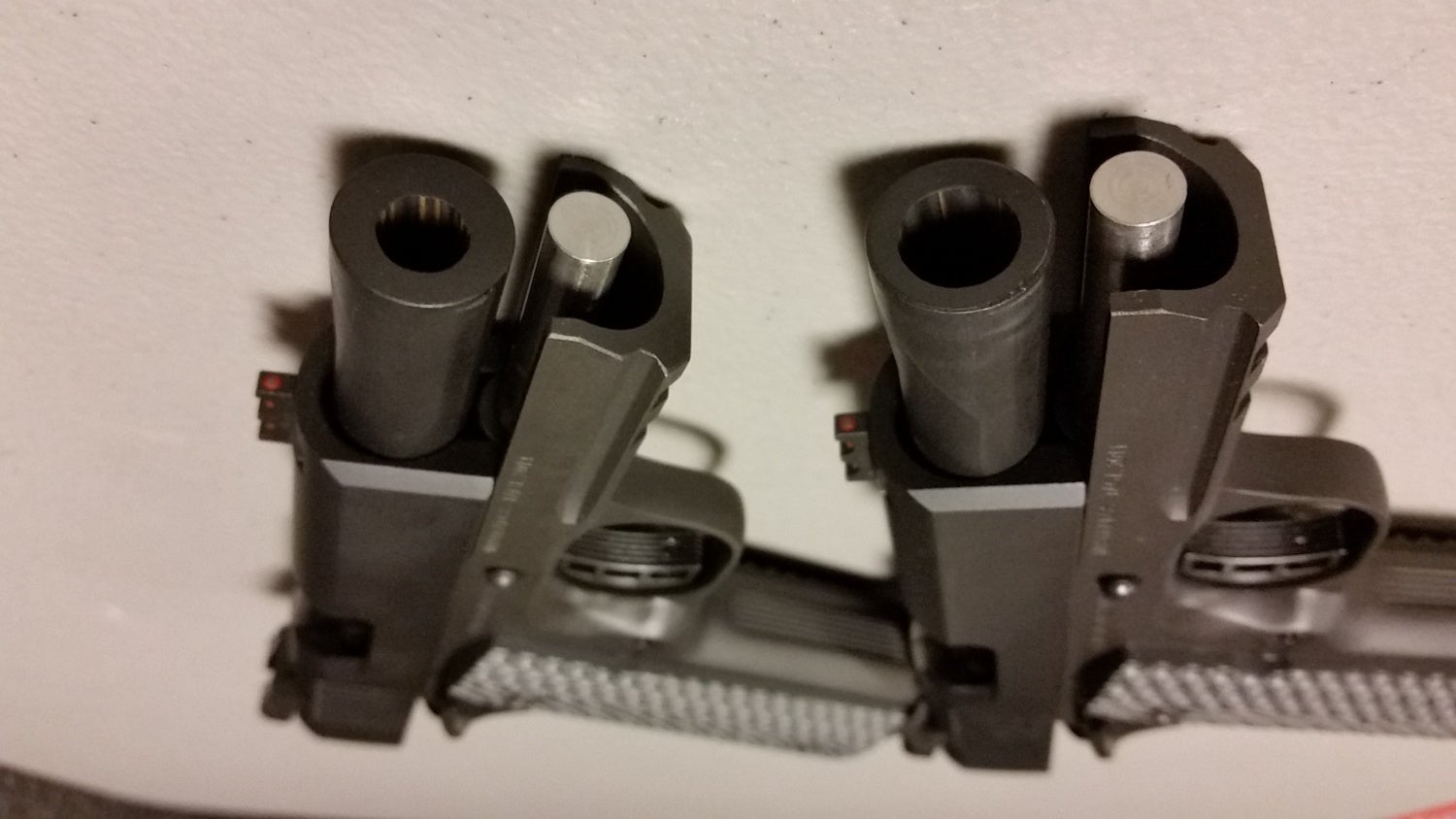
Bull barrels.
But, the most obvious and encouraging component to the handguns was the grips. Manufactured from G10, calling them aggressive would be an understatement, they are plain mean. The grips are an assault on the palm of your hands with the front 1/3 being scalloped like fish scales made of diamonds the rear form stepped straight-edges that a palm and fingers adhere to like Velcro. Simply put, the grips keep the gun in place. I swear you could put Crisco on your hands, turn your hand palm to the ground and open your fingers and the gun would not leave. Thank the heavens RIA opted for a smooth front strap or I might call handling the gun from grippy to “torture.”
The finish on both was a solid matte black with the only color punctuating the otherwise dull exterior the red fiber optic sight, gunmetal grey G10 grips, and laser-engraved logo to the rear of the slide. It was an impressive handgun, if only for the demure nature by which it carried itself.
Shooting & Living with the Tac CS’
As the guns were received in the winter in OH, opportunities to shoot outdoors were rather limited. I could have opted to freeze my derriere off, but considering these handguns are normally kept warm from body heat, I (selfishly) opted to keep testing indoors. That said, the firearm was carried daily for a few weeks in a custom Kydex holster manufactured by a friend (more on that later) and I was fortunate to not have to test it outdoors in a real emergency scenario.
Testing was done indoors at ranges from 3 to 50 yards under optimal conditions. The range is held at relatively stable temperatures above 60 degrees (they circulate outside air), minimal humidity, and under fluorescent lighting. The majority of ammunition used for testing was Freedom Munitions reloads (200 gr RN for .45 ACP and 147 grain RN 9mm). Defensive ammunition was also tested for including Geco, Federal XST, and Hornady XTP.
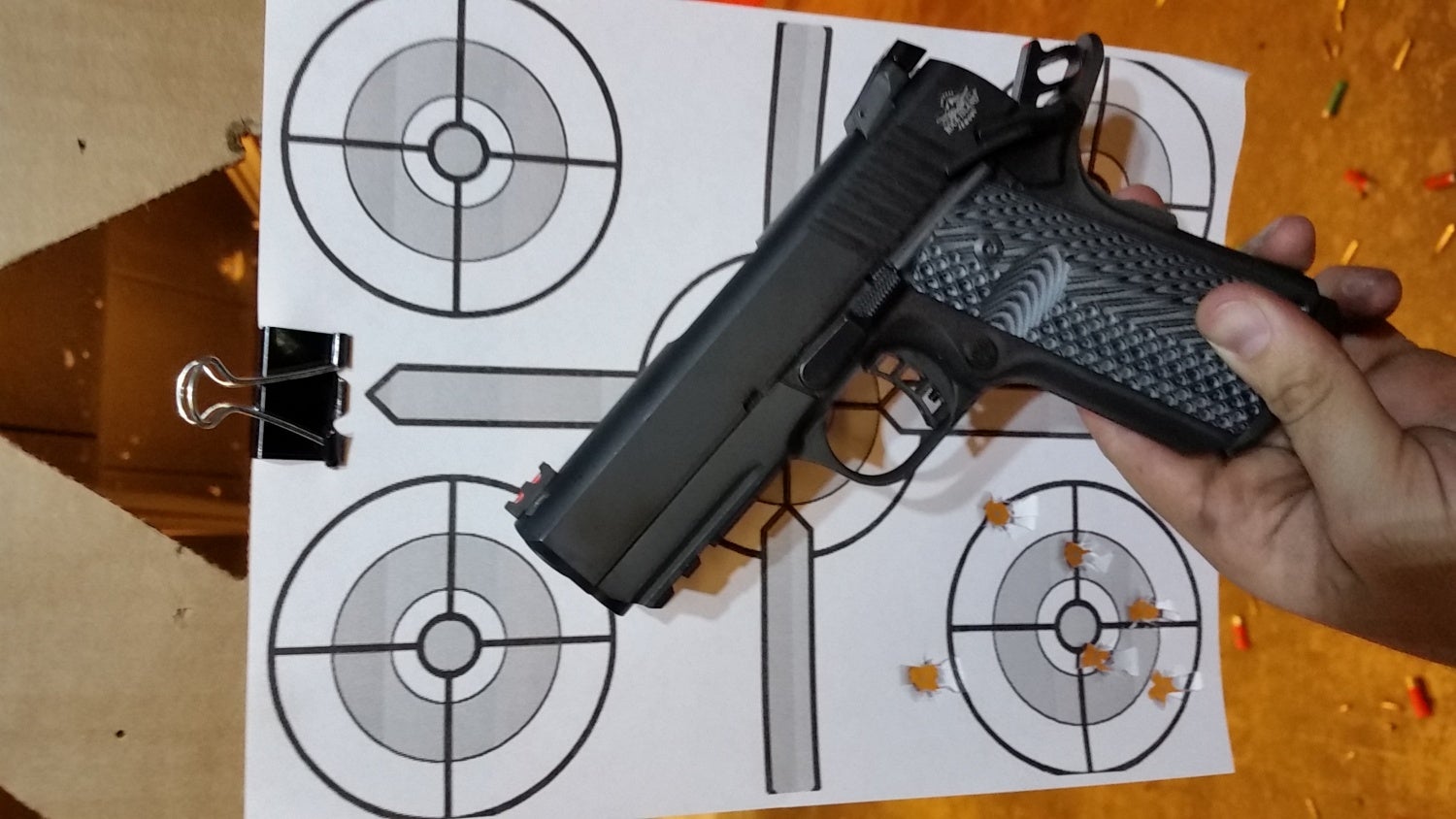
Group in the lower left. Not bad for offhand.
Magazine capacity for the handguns was 8 rounds of .45 ACP and 9 rounds of 9mm in single-stack magazines. The 45 magazines were nice and glossy with cut-outs for easy round-counts. The floor plate had an angled front lip to assist with ripping a magazine out, if needed. On the other hand, the 9mm magazines felt “cheap” and those they were the first choice for the cost-savings to get the handguns their needed features. It had a flat and flush floor plate that was decidedly not “tactical.”
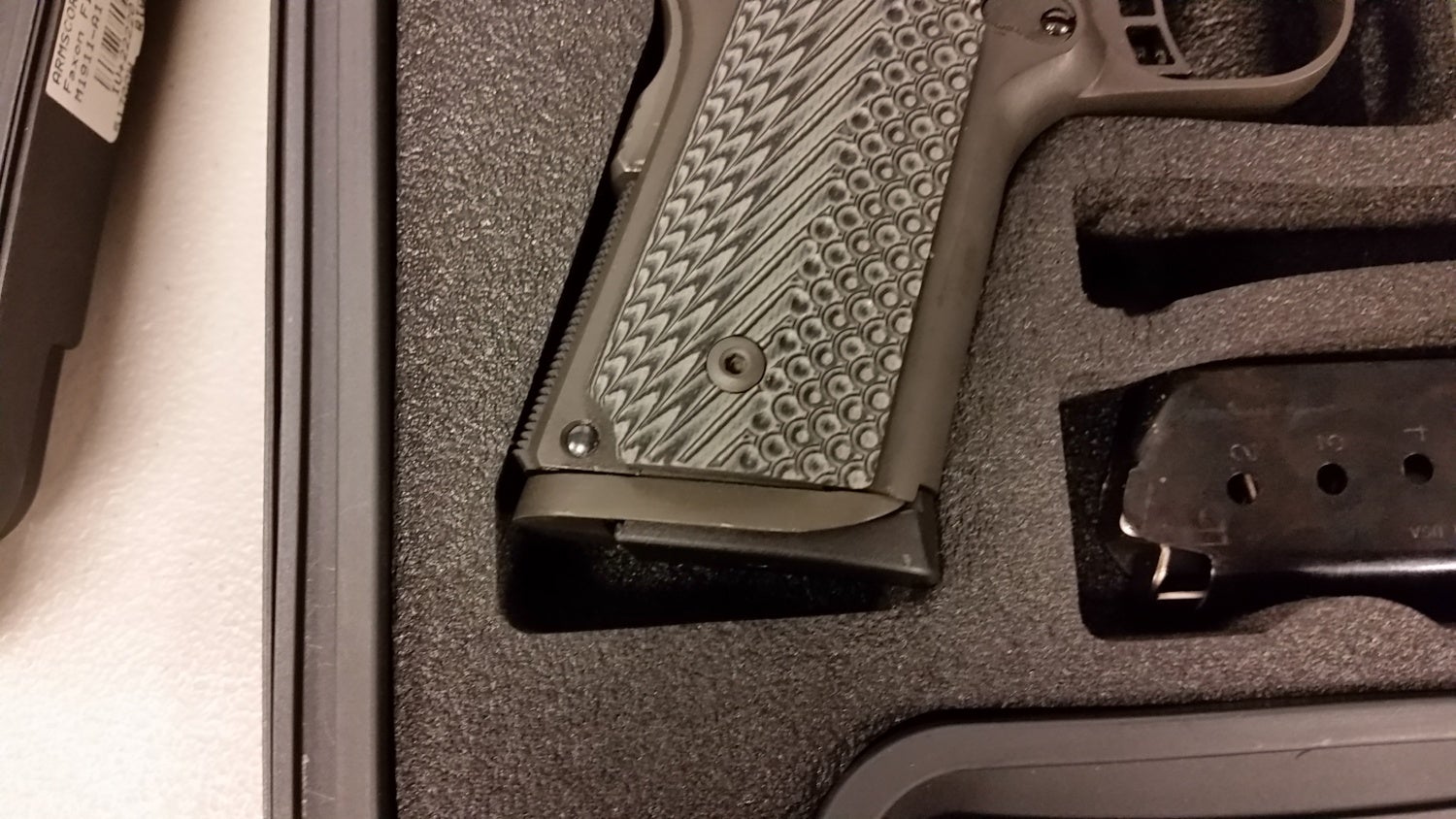
.45 ACP
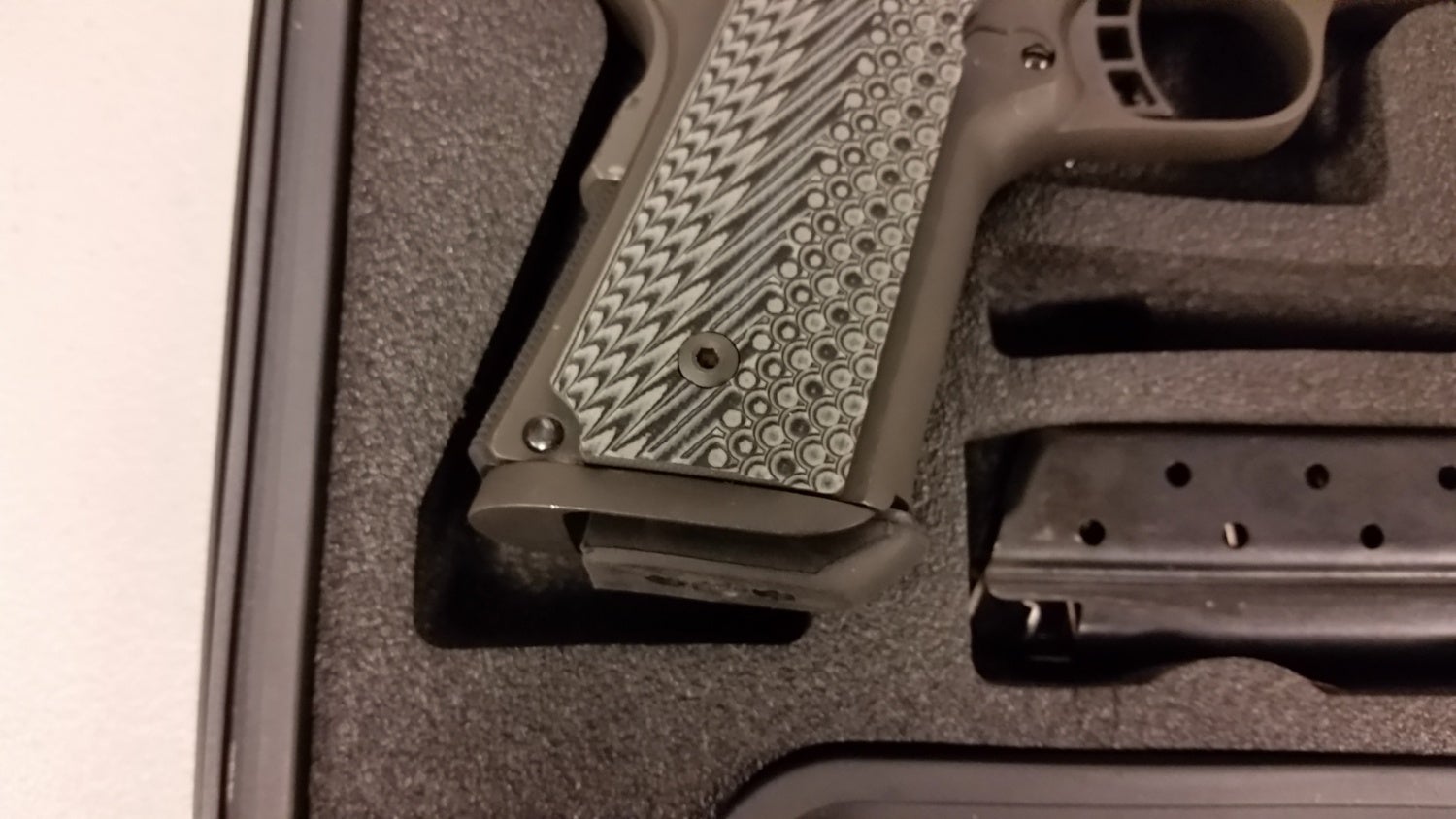
9mm.
Unfortunately, the first 9mm handgun sent by RIA was having issues with 9mm magazines dropping free. The rear lip of the expanded feed port was protruding into the magazine well causing magazines to not drop-free without being rocked forward. RIA was incredibly responsive and had labels sent the next day and the handgun returned quickly with armorer’s notes on the issue and fix. After the return of the 9mm handgun, the magazines both loaded up and dropped-free without issue.
While I could wax on the weapons manipulation of the TAC Ultra CS 1911’s, I will leave it at this, they are 1911s true and through. The slide release is in the same awkward spot, the safeties are disengaged intuitively, and the single-action trigger is no better or worse than similar in the field. Not top-notch, but with only minimal take-up and solid breaks at 4.1 and 4.5 lbs (tested with a Lyman trigger pull meter) for the .45 and 9mm, respectively.
Upon earnestly handing the handguns and putting them in the firing position, their weight becomes apparent quickly. The bull barrels and extended dust covers push the weight up and forward of the typical 1911. Its not a bad thing, but at nearly 3 lbs for each, loaded, those sensitive to such things will notice and get tired faster. Personally, I have the upper body strength but the weight was noticeable in the holster and my EDC belt, which I constantly had to adjust during the day for falling down. On a good note, the handguns forced me to upgrade to a true gun belt, but being the value-conscious buyer I am—I did not enjoy the added expense.
Expanding further on the topic of weight, I was not a fan of the weight of the 9mm version. In this case RIA opted to not modify the handgun for the caliber instead making the bore smaller on the barrel. As such, the handgun felt extremely heavy for the caliber and capacity. That said, the weight did offset in terms of recoil reduction but 9mm has not been known to be a particularly snappy round.
Shooting was a pleasant experience, for about two magazines each. After that point, the very grippy grips started to show their true colors and bit into the hand. After about 150 rounds, I had to stop and get my gloves to continue firing with my hand feeling raw. Recoil for the TAC Ultra’s was slightly less than other 1911s I have fired, which I would attribute to the weight. In typical fashion, both were a solid “push” on the hand with the 9mm being slightly more comfortable for rapid firing.
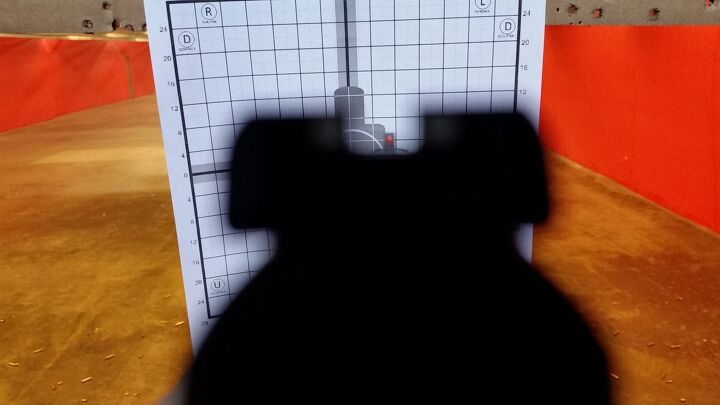
Focus on front fiber optic
Accuracy for the two models was nearly identical with the 9mm’s group edging out the .45 by a hair. At 10 yards (what I would consider standard for a handgun engagement), both handguns kept groups under 2” off-hand using the Freedom Munitions reloads. The adjustable sights were a huge plus in this area. The .45 ACP was perfect for windage but needed to be moved up slightly and the 9mm had significant adjustment needed to bring it on zero.
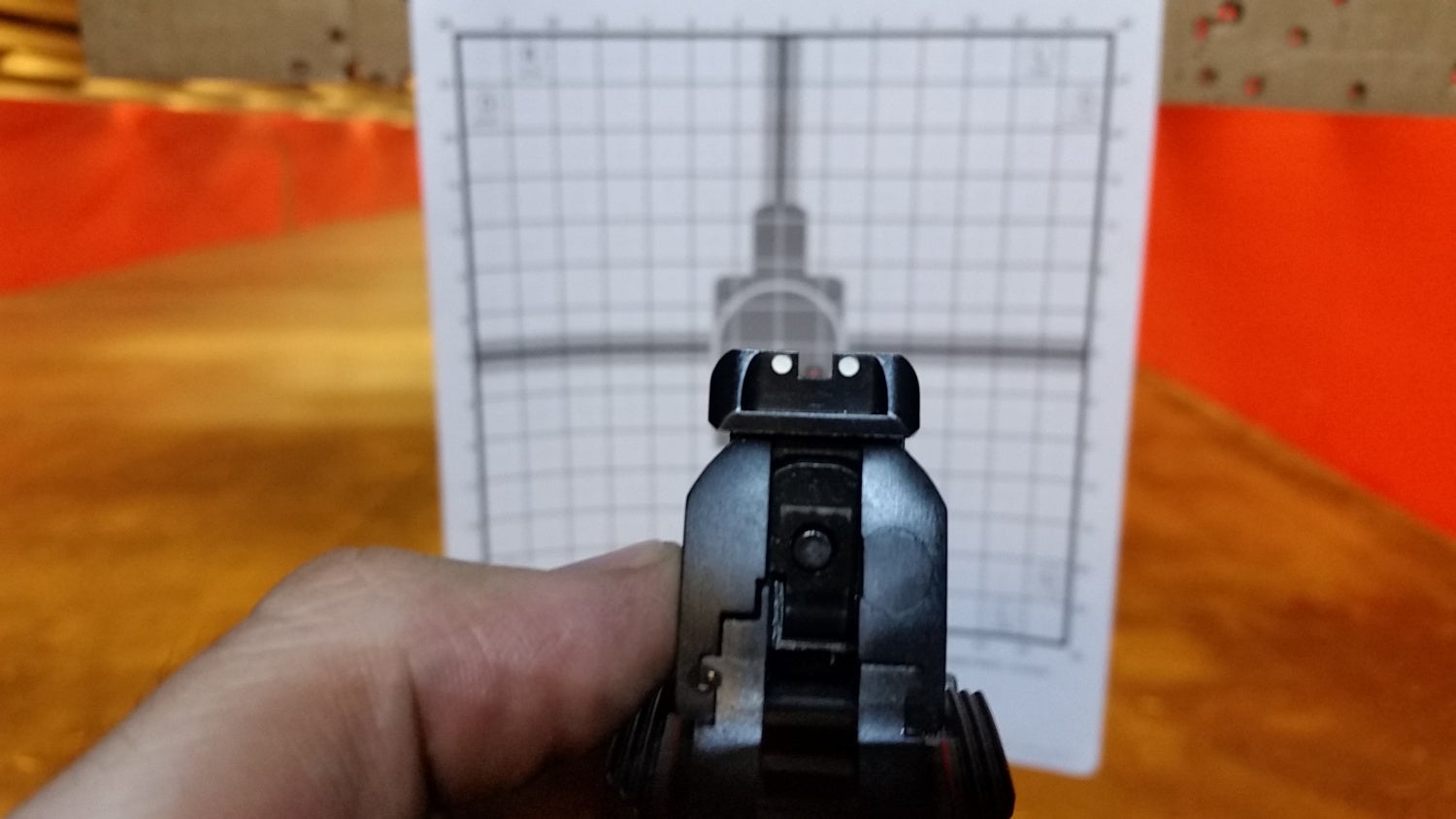
Sights
Reliability with both was flawless, but one had to be careful loading the 9mm magazines, especially the JHPs. The tapered round did not seem to want to settle into position compared to the nearly straight-walled .45. Short of purposefully limp-wristing, the handguns ate all the rounds I could feed them across a wide range of weights and powder loads. +P defensive rounds (Federal) and normal JHPs (Hornady) did not cause any issues. In fact, the guns seemed to like the heavier loadings during firing with recoil being perceptively smoother.
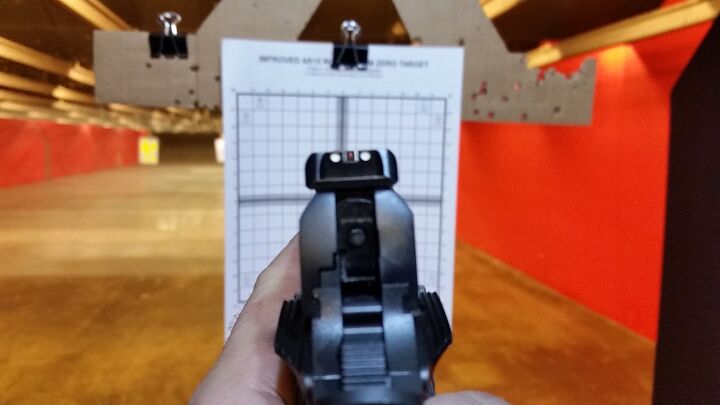
Focus on rear dots.
Considering that the guns are set up for EDC I continued testing after the test-firing stage confident in their ability to shoot defense loads. Swapping my typical Glocks for the 1911 was not an easy transition for me, primarily for the weight mentioned earlier. However, I did approve of the slimmer magazines.
Originally, I went with an inexpensive leather IWB holster but immediately ran into issues. As I am not sedentary on a daily basis, my movement was causing the handgun to rub against my body. The grips, which would be great in an emergency shoot, became a detriment to comfort. Within hours of holstering, I was chafed and within a day, raw. While I could wear an undershirt, I typically don’t and didn’t want to dress around the gun to that level.
The fix was relatively simple. I sent the handgun off to a friend who within a day returned it with a custom kydex piece which fixed two things 1) fit the extended dust cover nicely and 2) had a strip of kydex on the inside of the holster to protect my skin from the grips. From there, it was a smooth, comfortable ride.
As the weeks went on, I grew more accustomed to the handgun and appreciated it more than being “just a 1911.” The RIAs were solidly built and my initial concerns of the potential trade-offs for the price were put to rest. The handguns are good value.
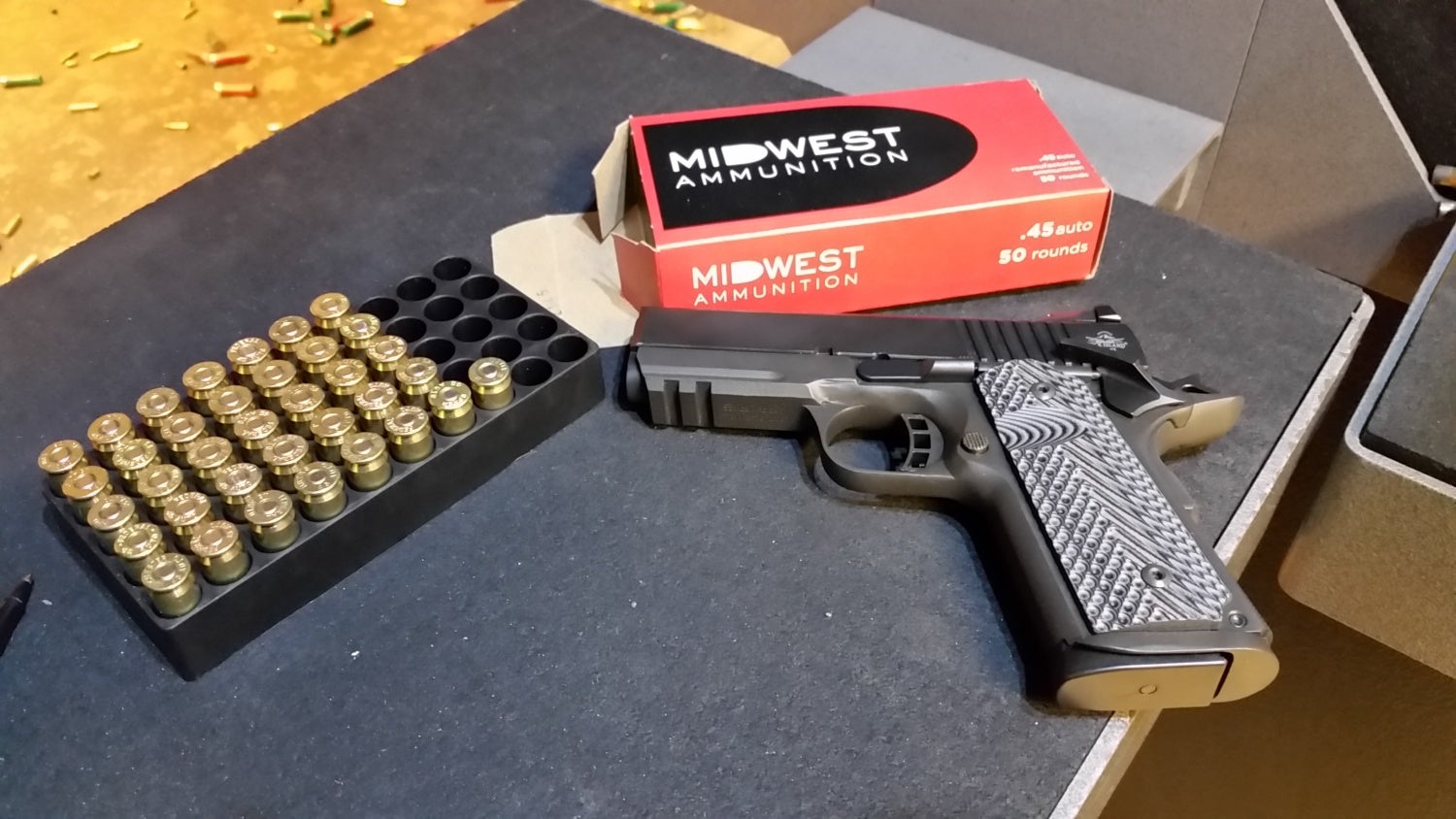
The Good:
- Solid, positive controls.
- Adjustable sights. Fiber optic front was good to go and easy to pick up.
- Amazing grip texture. If the gun leaves your hand, it was an Act of God.
- Bull barrels were consistent out to the tested ranges.
The Notable:
- Grip texture could be termed “too aggressive”. After a 250-round session my right hand was raw. Would not recommend any carry position that has the grip rubbing against skin.
- Triggers had some take-up, but broke clean like a typical 1911.
The Bad:
- Guns are heavy, especially for EDC. The 9mm is especially so as the gun is not lightened or otherwise modified for the smaller caliber. The big bull barrel feels front-heavy on that version.
- The first sent 9mm had an issue where the magazine well did not allow the magazines to drop free. It was fixed promptly, but buyers should look for the issue.
Final Thoughts:
It’s always difficult for me to wax on or laud the 1911 platform, but I came away liking the handguns. As such, what is most important to me is that guns function, period. This is especially true of guns designed for concealed carry. In this respect, the Rock Island Armory Tac CS 1911’s delivered.
Outside of the issue with the 9mm magazine, function was flawless across the multitude and variety of rounds shot. Each ate JHPs, FMJs, and powder loads of a variety of strengths with nary a complaint. Even cross-loading different types of rounds into the magazines and semi-limp wristing was not enough to get them to choke.
But, I came away liking the .45 more. On an emotional level and as a physical sensation, the .45 felt “right.” 9mm, to me, is just too small for the size and weight of the handgun unless the handgun is scaled for the caliber like the .380 Browning. Perhaps if the 9mm was double-stack, I would be able to recommend it.
Here’s my bottom line: Buyers should not fault the .45 for its 9mm sibling. I would carry the .45 ACP any day (with the right holster to keep it from rubbing or and undershirt.). For the street price of $545-615 (retail, $799) the features these 1911s bring to the table make them a compelling argument for your hard-earned money. Rock Island Armory and Armscor found the right balance.
Gallery
- .45 ACP
- 9mm.
- Group in the lower left. Not bad for offhand.
- Grippy!
- Sights
- Focus on front fiber optic
- Focus on rear dots.
- Bull barrels.
- The 1911 CS’ as they arrive with accessories.
 Your Privacy Choices
Your Privacy Choices
